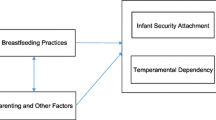Abstract
The transitional object attachments and persistent oral habits of 37 three-year-olds were examined in relation to their present and retrospectively rated infantile temperament. Children attached to a transitional object were differentiable from unattached children on infantile but not early childhood temperament, and the predictive temperament pattern differed from the pattern predicting oral habits. Transitional object attachments were independent from oral habits and were interpreted to serve distinct non-pathological developmental functions. The study suggests that temperament plays an etiological role in transitional object attachments, but that the status of the object as a developmental marker is ambiguous.
Similar content being viewed by others
References
Winnicott D: Transitional objects and transitional phenomena.Int J Psychoanal 34:39–97, 1953.
Randour M, Bondanza J: God as a transitional object: the concept of God in the psychological formation of females.Psychoanal Psychol 4:301–13, 1987.
Hausner R: Medication and transitional phenomena.Int J Psychoanal Psychother 11:375–98, 1985–6.
Litt CJ: Theories of transitional object attachment: an overview.Int J Behav Develpm 9:383–99, 1986.
Gaddini R, Gaddini E: Transitional objects and the process of individuation.J Am Acad Child Psychiatry 9:347–65, 1970.
Hong K, Townes B: Infants' attachments to inanimate objects.J Am Acad Child Psychiatry 15:49–61, 1976.
Parker CA: Mother-infant interactions and infants' use of transitional objects. Unpublished doctoral dissertation.Dissertation abstracts international 40(10B):5038–9, 1980.
Rudhe L, Ekecrantz L: Transitional phenomena: the typical phenomenon and its development.Acta Psychiatr Scand 50:381–400, 1974.
Stevenson O: The first treasured possession.Psychoanal Study Child 9:199–217, 1954.
Garrison W, Earls F: Attachment to a special object at the age of 3 years: behavior and temperamental characteristics.Child Psychiat Hum Develpm 12:131–41, 1982.
Ekecrantz L, Rudhe L: Transitional phenomena: frequency, forms, and functions of especially loved objects.Acta Psychiatr Scand 48:261–73, 1972.
Schaffer HR, Emerson PE: Patterns of response to physical contact in early human development.J Child Psychol Psychiatry 5:1–13, 1964.
Wulff M: Fetishism and object choice in early childhood.Psychoanal Q 14:450–71, 1946.
Roiphe H, Galenson E: Some observations on transitional object and infantile fetish.Psychoanal Q 44:206–31, 1975.
Passman RH: Arousal reducing properties of attachment objects: testing the functional limits of the security blanket relative to the mother.Develop Psychol 12:468–69, 1976.
Passman RH: Providing attachment objects to facilitate learning and reduce stress: effects of mothers and security blankets.Develop Psychol 13:25–28, 1977.
Boniface D, Graham P: The three-year-old and his attachment to a special soft object.J Child Psychol Psychiatry 20:217–24, 1979.
Newson J, Newson E, Mahalski PA: Persistent infant comfort habits and their sequelae at 11 and 16 years.J Child Psychol Psychiatry 23:421–36, 1982.
Brody S, Axelrad S:Mothers, fathers, and children: explorations in the formation of character in the first seven years. New York: International Universities Press, 1978.
Cohen KN, Clark JA: Transitional object attachments in early childhood and personality characteristics in later life.J Pers Soc Psychol 46:106–11, 1984.
Morris H, Gunderson JG, Zanarini MC: Transitional object use and borderline psychopathology.Am J Psychiatry 143:1534–8, 1986.
Horton P, Louy T, Coppolillo: Personality disorder and transitional relatedness.Arch Gen Psychiatry 30:618–22, 1974.
Mahalski PA: The incidence of attachment objects and oral habits at bedtime in 2 longitudinal samples of children aged 1.5–7 years.J Child Psychol Psychiatry 24:283–95, 1983.
Sherman M, et al: Treasured objects in school-aged children.Pediatrics 68:379–86, 1981.
Passman RH, Weisberg P: Mothers and blankets as agents for promoting play and exploration by young children in a novel environment: the effects of social and nonsocial attachment objects.Develop Psychol 11:170–7, 1975.
Busch F, et al: Primary transitional objects.J Am Acad Child Psychiatry 12:193–214, 1973.
Hong K: The transitional phenomena.Psychoanal Study Child 33:47–49, 1978.
Carey WB: A simplified method for measuring infant temperament.J Pediatrics 81:414, 1972.
Thomas A, et al:Behavioral individuality in early childhood. New York: New York University Press, 1963.
Thomas A, Chess S:Temperament and development. New York: Brunner/Mazel, 1977.
Barron AP, Earls F: The relation of temperament and social factors to behavior problems in three-year-old children.J Child Psychol Psychiatry 25:23–33, 1984.
Bowlby J: Self-reliance and some conditions that promote it. In:Support, innovation, and autonomy, ed. Gosling R. London: Tavistock, 1973.
Greenacre P: The fetish and the transitional object.Psychoanal Study Child 24: 144–64, 1969.
Hamilton V:Narcissus and Oedipus: the children of psychoanalysis. London: Routledge, 1982.
Author information
Authors and Affiliations
Rights and permissions
About this article
Cite this article
Haslam, N. Temperament and the transitional object. Child Psych Hum Dev 22, 237–248 (1992). https://doi.org/10.1007/BF00707666
Received:
Revised:
Accepted:
Issue Date:
DOI: https://doi.org/10.1007/BF00707666




